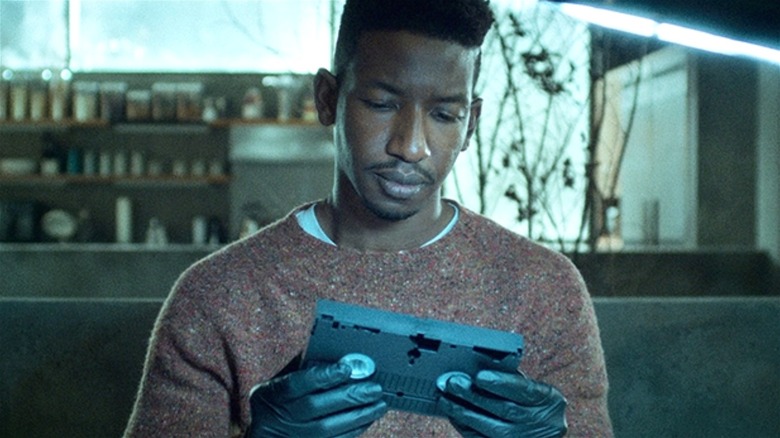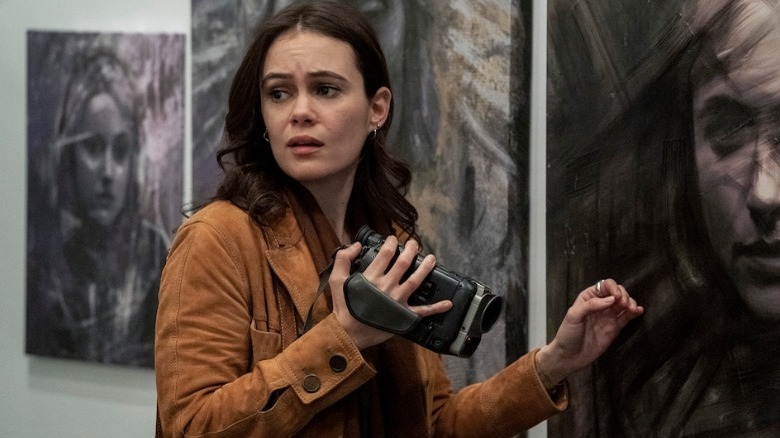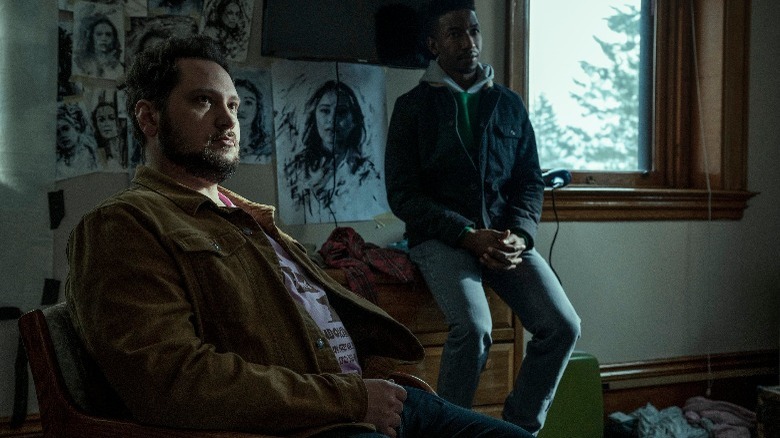Archive 81's Visual Style Is An Homage To Films Like Rosemary's Baby
Crafting a compelling found-footage horror story can be tricky. The format can be exhausting if not used effectively, and the scares can only land when supported by a well-crafted story. The first season of Netflix's "Archive 81" managed to stick the landing by offering a taut puzzle-box mystery that incorporated the found footage format to strong effect. Unfortunately, the horror series was rudely canceled by Netflix, which had ended on a delicious cliffhanger, leaving fans of the show (and me) fuming.
There are several reasons for the show's popularity. Firstly, the series is based on the popular horror podcast of the same name, and the narrative weaves together a thrilling tale about lost tapes, cults, mysterious disappearances, and demonic activity. At the heart of "Archive 81" is a tale of radical empathy and compassion, in which the fates of Dan (Mamoudou Athie) and Melody (Dina Shihabi) are intertwined across space and time. Secondly, the show ended on a massive "what if?" scenario, which birthed countless theories about the nature of time-space swapping and temporal continuity within the context of the show.
Perhaps one of the most interesting aspects of the show is its unique visual style, which keeps shifting between found footage aesthetics and isolated characters in darkened rooms. This helps heighten the tension built into the slow-burn nature of the events, and brands "Archive 81" with a unique, retro-esque aesthetic. Although the show draws some of its aesthetic from established entries in the found footage genre, it also drew inspiration from some classic films and shows to craft its rich, atmospheric world.
The X-Files, and the power of belief
In 1994, a mysterious apartment building in New York City, the Visser, burns down, leading to the disappearance of many, including one Melody Panderas. As a part of his archival work years later, Dan needs to sift through Melody's recorded tapes to unveil the mystery of the Visser. However, this process exposes him to realities that end up warping his own, which leads to a tussle between skepticism and the need to believe. At the same time, Melody's tapes reveal that she was going through a similar process back in 1994 after she had stumbled upon some unsavory secrets about the inhabitants of the building.
"Archive 81" writer and executive producer Rebecca Sonnenshine told Looper about this trope of two characters navigating the unknown, citing "The X-Files" as a major narrative and aesthetic influence for the show. Sonnenshine explained that "The X-Files" is "ephemeral" for her and that the visual feel of that classic series inspired her show's dark corridors and abandoned rooms, which are often punctuated by the weak beam of flashlights. This interplay of creeping in the dark and investigating corners with flashlights adds a considerable amount of tension to Melody and Dan's actions, as a lot is at stake if either of them were to be caught by the wrong people.
Both Dan and Melody deal with supernatural occurrences that are triggered by real people around them, which adds to their confusion about the nature of the unknown. Although they are no Mulder and Scully, one of them is more inclined to embrace the unknown, while the other copes with an often unhealthy dose of skeptical rationalism. Dan and Melody do manage to meet each other halfway, which opens up the possibility of altering the past and the future along various timelines.
Spooky aesthetics, high-concept ideas
"Archive 81" feels like a loving homage to the horror genre, especially when the show laboriously unravels character backstories that eventually tie in beautifully with climactic reveals. There is substantial weight and atmosphere in almost every haunting sequence, which aims at piquing the viewer's curiosity at every turn. Escalating anxiety and paranoia are an essential part of "Archive 81," and Sonnenshine reveals that this aspect was inspired by a ton of '70s horror films, including "Rosemary's Baby."
The reason why "Rosemary's Baby" is such an effective horror offering can be attributed to the film's perpetually unsettling atmosphere, which reaches a fever pitch when Rosemary (Mia Farrow) learns the truth about the terrible conspiracy surrounding her. Melody is in a similar situation, as the residents of the Visser attempt to lure her into a set path that helps them meet their own ends, while a demonic entity lurks in the shadows. There are several visual references to Roman Polanski's film, including a shady cult congregating to chant an ancient entity's name, along with dream sequences that prove to be chillingly real. While "Rosemary's Baby" ends on a note of traumatized acceptance, "Archive 81" ends on a note of hope, which is soon snatched away, thanks to the interference of darker forces.
Sonnenshine also paid homage to shows that dabble in high-concept paranormal storylines, such as "Fringe," along with paranoid thrillers such as "The Conversation" and surreal horror movies like "Don't Look Now." These influences are in full display during high-stakes investigative sequences with sparse dialogue, and when everyday objects take on special significance due to the unnerving nature of events. Visually speaking, "Archive 81" is a feast, as it combines the basic beats of a paranoid thriller slash cult horror and puts its own spin on it. Needless to say, it works.


